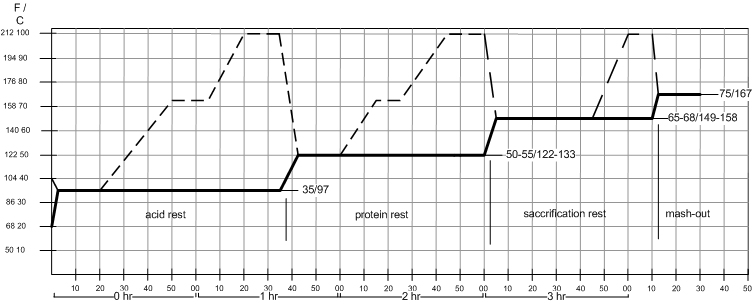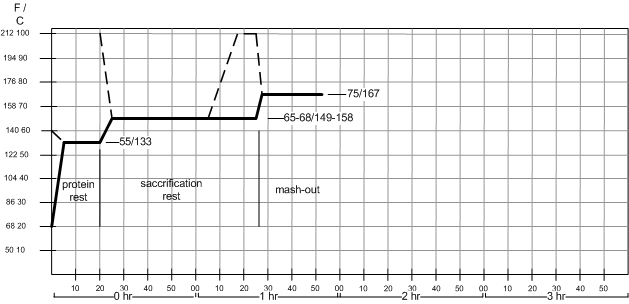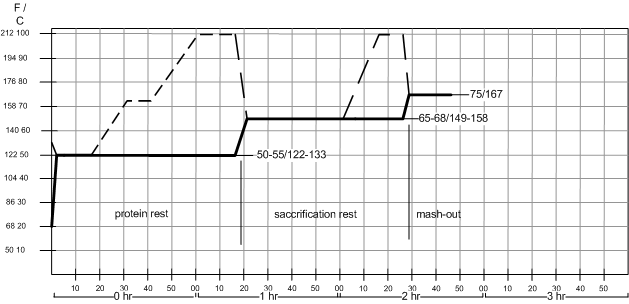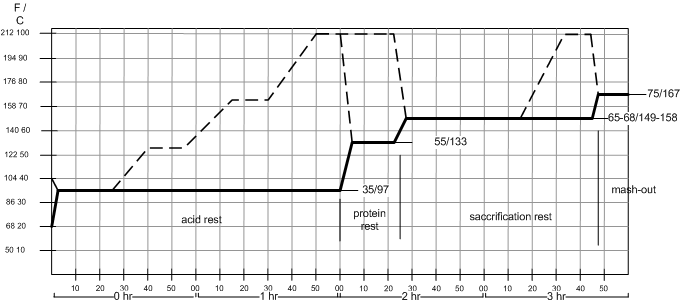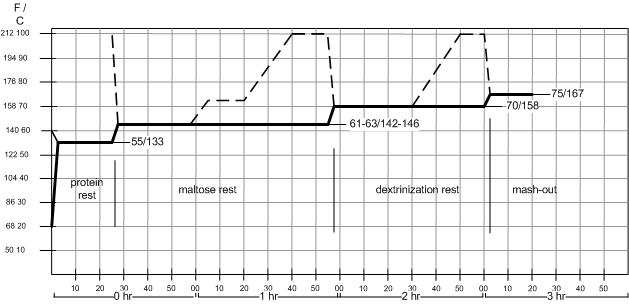Difference between revisions of "Decoction Mashing"
(→Further reading.) |
(→Enhanced Double Decoction) |
||
| Line 75: | Line 75: | ||
Rest the mash for saccrification. Check for conversion and when the desired mash time rest time is up and conversion was achieved, pull the 2nd decoction. Heat it to boiling, boil for 5-20 min and return it to the main mash to reach mash-out. | Rest the mash for saccrification. Check for conversion and when the desired mash time rest time is up and conversion was achieved, pull the 2nd decoction. Heat it to boiling, boil for 5-20 min and return it to the main mash to reach mash-out. | ||
| + | |||
| + | =====Variation====== | ||
| + | |||
| + | If you want a highly fermentable wort and truly boil and convert almost all of the starches in the decoction, this variation should get you there: | ||
| + | |||
| + | Dough-in in at the acid rest in your your boil kettle. Stir well occasionally to make sure you are dissolving the enzynmes into the mash water. While the mash is resting, preheat your mash tun with some boiling water. This will prevent a significant temperature drop later. | ||
| + | |||
| + | After the mash has been resting for 10 - 20 min and the pH is corrected, remove 40% of the liquid | ||
====Hochkurz Double Decoction==== | ====Hochkurz Double Decoction==== | ||
Revision as of 15:47, 25 March 2008
A decoction mash is a type of mash in which the various mash temperatures are achieved by removing part of the mash, boiling it in a separate vessel, and then using it as infusion water to heat the remainder of the mash. It is traditional in many continental European beer styles, especially in Germany and the Czech Republic.
Decoction mashing is not common among home brewers, since it has a reputation as a time and labor-intensive process. But a decoction mash is basically just a step infusion mash where some of the grist is heated along with the infusion water. While it does take some extra time and require some extra stirring, it is a procedure that can be performed by most home brewers.
Contents
[hide]History of the Decoction Mash
Decoction mashing refers to removing a part of the mash, boiling it and returning it to the main mash to increase its temperature to the next rest. This mashing procedure originates from a time when malt quality was not consistent and temperatures could not be measured. The long boiling of the grain makes the starches more accessible for the enzymes. This is particularly important for undermodified malts where the cell walls are not as broken down as they are in well modified or overmodified malts. The boiling of a defined portion of the mash and returning it to the main mash to raise the temperature also helped the consistency in mashing temperatures before thermometers were available.
Chemistry of the Decoction Mash
Today even most European malts are generally well modified and can be used in infusion step mashes or even single infusion mashes, thus removing the need for decoction mashing. But decoction mashing is still widely used, particularly in German brewing. Many brewers believe that the boiling of the mash gives the beer a flavor profile that cannot be achieved otherwise. But, especially in the home brewing community, there has been debate about the actual benefits of a mash as labor intensive as a decoction mash. Many say that with the malts that are available to the home brewer decoction mashing doesn't make for a difference and if there is a difference it could also be achieved by the use of specialty malts. But in the end every brewer has to determine that for him or herself.
Decoction Mash Procedure
The basic procedure for performing a decoction mash is very simple. Water is added to the grist to reach the initial mash temperature. One the first temperature rest is complete, a portion of the grain and water is scooped or shoveled out of the mash tun and into the kettle or another heated vessel, where it is brought to a boil. The portion removed, which can often be as much as a third of the grist, is called the decoction.
The decoction may require stirring during heating to avoid scorching the grain; this adds some extra work during the mash. The decoction step also adds time to the mash, since unlike the infusion water in a step infusion mash, the water cannot be heated during a rest.
After boiling, the decoction is returned to the mash tun to achieve the next temperature rest.
Sample Decoction Mash Schedules
This section contains discussions of a number of sample schedules for decoction mashes, including single, double, and triple decoctions. The brewer should bear in mind that some mash schedules are better suited for use with modern, well-modified European malts than others.
Triple Decoction
The triple decoction is the grand father of all decoction mashes. This is how the first Pilsners were brewed in Pilzen and how many traditional German breweries brew their dark beers, such as Munich Dunkel, Bock, and Doppelbock, to this day.
The triple decoction mash employs 3 main mash rests: acid rest, protein rest and saccrification rest. At each of these rests a decoction is used to reach the next rest until the mash-out is reached. The acid rest is a convenient rest to do mash pH adjustments. Not only does it serve to lower the pH by simply using the phosphatase and other acid forming enzymatic activity, but since there is no enzymatic activity that can have a detrimental affect on the final result, there is no rush to move to the next rest.
There are several formulas out there for calculating the decoction volume. Some of them are simple and others try to account for factors such as the heat capacity of the grains and the mash-tun. The easiest way however is to estimate the decoction volume with a simple formula like this:
decoction volume = total mash volume * (target temp - start temp) / (boil temp - start temp)
and add about 15 - 20%. The idea is to decoct more mash than necessary. When the decoction is added back to the main mash, it is not all added at once. Instead it is added in steps while the actual temperature of the mash is constantly checked. This requires a thorough mixing of the mash after each addition. Once the target temperature is reached the remaining decoction is left to cool and added once its temperature is close to the mash temperature. By doing so one can account for additional factors that affect the actual needed decoction volume such as: evaporation during the boil, unexpected temperature drop in the main mash and others.
The thickness of the decoction depends on the thickness of the main mash. Though it is preferred to leave a lot of the liquid back in the mash tun, the decoction should not be to thick (grain still being submerged in liquid) to make stirring it easier and keep it from scorching easily. If the main mash can be kept at the preferred thickness of 1.5 - 2 qts/lb (3-4 kg/l) the decoction should have a thickness of 1-1.25 qts/lb (2-2.5 kg/l) this is about the thickness of a standard single infusion mash. At this thickness and with gentle heating, only little stirring is necessary to keep the mash from scorching. For lager grists (high gravity beers) the thickness of the mash may however be limited by the volume of the mash tun.
All the decoction schedules provided here assume a decoction rise temp of 2-4 *F/min (1-2 *C/min). This is what is generally recommended in the literature for heating the mash. There is also a saccrification rest at 155 - 162 *F (68 - 72 *C). The purpose of this rest is to utilize the enzymatic power of the decoction before its enzymes are destroyed by further heating. This is particularly important when brewing beers with a large percentage of the enzymatic weaker dark base malts. This rest doesn't have to be held at the main saccrification temperature. It is sufficient to rest in the alpha amylase range where the conversion is also done much quicker. After the decoction is converted or almost converted (iodine test) the heating of the mash is resumed. To hold this rest the pot can be taken off the burner and wrapped in blankets for insulation.
The decoction is then boiled for 10 - 40 minutes. Shorter boil times for light colored beers, longer boil times for dark colored beers. If only gentle heat is applied during the boil, stirring should only be necessary occasionally. Similar to wort boiling, excessive thermal loading of the decoction can result in a burnt flavor of the beer. If the decoction is boiled for an extended amount of time evaporation losses can be compensated with the addition of water (which can also be added after the decoction has been pulled, where it helps in tinning it out and makes it more manageable.
Once the decoction is then added to the main mash to reach the protein rest. The rest temperature and time before pulling the next decoction should be based on the malt that is used. Less modified malts benefit from a rest closer to 122 *F (50 *C) which produces more amino acids, which is an essential yeast nutrient. In undermodified malts the protein conversion has not been driven far enough to allow for sufficient wort FAN (free amino nitrogen) without the use of a more intensive protein rest. If the malt is a well modified modern continental malt, the protein rest temperature should be kept closer to 133 *F (55 *C) and the next decoction should be pulled 5 - 10 minutes after the rest temperature has been reached. This serves to protect more of the medium chained proteins that are important for body and head retention. Decoction that allows for a shorter protein rest in general will be described later.
A decoction is pulled again, rested for conversion and then brought to a boil. This time to reach the saccrification rest temperature. This temperature is similar to the saccrification rest temperature that is used for a single infusion mash, but the same temperature that was used in a single infusion mash may not give the same fermentability in a decoction mash. Boiling has destroyed more of the enzymes while it has made the starch also more easily accessible. The former would lead to a less fermentable result while the latter would shift the fermentability towards a more fermentable wort. This is only to illustrate that experimenting with the saccrification rest temperature might be necessary for the optimal result. The saccrification rest temperature that would have been used in a single infusion mash is however a good starting point.
After holding the saccrification rest for about 45 min or longer if starch conversion is not complete after that time, the final decoction is pulled. This decoction can also be thinner and doesn't have to be rested for starch conversion any more, since the starches have already been converted and any enzymes remaining in the main mash will be denatured by the higher temperatures of the final step.
Single Decoction
In a single decoction mash only one decoction is used. This decoction can be used to reach any rest, but most commonly it is used to get to mash-out. This can be a simple enhancement of a single infusion or step mash.
The mash schedule shown above is well suited for European and continental lager malts. It features a short protein rest at the higher end of the temperature range for proteolytic activity, a single temperature saccrification rest and a decoction to get to mash-out. Calculate your strike water to aim for a protein rest between 53 and 55 *C (129 - 133 *F) at a mash consistency of about 2.5 l/kg (1.2 qts/lb). This will put emphasis on the protein degrading enzymes that produce the medium chained proteins which are good for head retention and mouth feel. The well-modified modern malts already have enough short proteins (amino acids) and a rest closer to 50 *C (122 *F) is not necessary. Dough-in and check the temperature. Plan on holding this temperature for 20 min. During this time bring about half of the amount of water, that was used for dough-in, to a boil. The pH of the mash should be checked and corrected if it is not within the 5.2 - 5.5 range. When the protein rest is over, use a heat resistant vessel to scoop the boiling water into the mash. This is best done by holding the thermometer in the mash with one hand and scooping the water or stirring with the other hand. It is important to stir the mash well to even out its temperature. Add water until the desired mash temp of 65 - 68 *C (148 - 155 *F) is reached. You will notice that the tinning mash makes stirring easier. The resulting mash will have a consistency of about 3.5 - 3.75 l/kg (1.8 qts/lb) which is great for German style beers. Hold this rest for 45 min.
Check for conversion. Calculate the amount of decoction necessary to get to the mash-out temperature of 74 - 76 *C (165 - 170 *F) and pull this decoction. In order to prevent scorching get good mix of liquid and grains. This decoction should be brought to a boil over the next 10 to 15 minutes. A gentle flame while keeping the pot covered will prevent scorching even without the need of constant stirring. When the decoction comes to a boil remove the lid (watch out for boil-overs) and let it boil for 10 - 30 min. Shorter for light worts and longer for darker worts.
Double Decoction
Classic Double Decoction
The classic version of the double decoction is a shortened tripple decoction. It omits the acid rest and starts with the protein rest. Because of this only 2 deooctions are needed to get to mash-out. One to get from the protein rest to the saccrification rest and another one to get from the saccrification rest to mash-out. Like the tripple decoction, this mash rests the main mash at the protein rest for a long time. With well modified lager malts, this may result in overly extensive protein degradation. The following two sections show mash schedules that avoid this problem.
Enhanced Double Decoction
This is a mash schedule that was taken from German brewing literaure [Narziss,2005]. The great thing about this mash is that it is almost as intensive as a triple decoction, when it comes to the amount of mash that is boiled, but a little bit shorter and without a long protein rest. The basic idea of this mash is to pull a decoction that is large enough to get the mash from acid rest directly to the saccrification rest. But when this decoction is returned to the main mash, it is returned in 2 parts: first to reach the protein rest and later to reach the saccrification rest. The second decoction is done to reach mash-out.
This mash starts like the triple decoction. Dough-in is done to reach the acid rest where the mash pH is corrected if necessary. Now a large decoction (about 50 - 60% of the mash) is pulled and heated. It is advisable to add some water 5-10% of the decoction volume to compensate for boil-off and thin it out a little. Due to the size of the decoction it should be rested for protein rest and must be rested for the saccrification rest. The saccrification rest is necessary to get the most out of the enzymes in this mash as they will be destroyed once the decoction is brought to a boil. This rest can be done at 155 - 162 *F (68 - 72 *C) where the conversion should only take 15 - 20 min. Taking the pot off the burner, closing it with a lid and wrapping it in blankets for insulation works very well. Check temperature and conversion after 15 min. When fully or almost converted, return the pot to the burner and start heating it gently again to bring it to a boil. Watch out for the foam-up of the decoction shortly after it comes to a boil.
The mash is now boiled from 10 - 30 min. After that a heat resistant vessel is used to scoop some of the decoction back into the main mash. Stir well and check the temperature of the main mash. Continue adding the decoction until the desired protein rest temperature is reached. After that the main mash is rested for 15 - 20 min while the rest of the decoction is still boiling. Once the protein rest is over, continue adding the decoction, stir and check temperature until the desired saccrification rest temperature is reached. Hopefully enough decoction was pulled to reach this rest. If some decoction is left over once the rest temperature is reached, let it cool and add it when its temperature is close to the temperature of the main mash.
Rest the mash for saccrification. Check for conversion and when the desired mash time rest time is up and conversion was achieved, pull the 2nd decoction. Heat it to boiling, boil for 5-20 min and return it to the main mash to reach mash-out.
Variation=
If you want a highly fermentable wort and truly boil and convert almost all of the starches in the decoction, this variation should get you there:
Dough-in in at the acid rest in your your boil kettle. Stir well occasionally to make sure you are dissolving the enzynmes into the mash water. While the mash is resting, preheat your mash tun with some boiling water. This will prevent a significant temperature drop later.
After the mash has been resting for 10 - 20 min and the pH is corrected, remove 40% of the liquid
Hochkurz Double Decoction
This version of a double decoction mash is known as Hochkurz Mash in German brewing [Narziss, 2005]. It uses a 2 temperature saccrification rest. The first decoction is used to get from the 1st saccrification rest (maltose rest) to the 2nd saccrification rest (dextrinization rest) and the 2nd decoction is used for mash-out. The dough-in can happen with the protein rest or the maltose rest.
To optimize the use of the beta amylase and produce a wort with high levels of maltose, German brewers often use a 2 step saccrification scheme. The first rest, usually held at 140 - 146 *F (60 - 63 *C) gives the beta amylase time to break down the glucose chains. There is already sufficient alpha amylase activity to provide enough glucose chain ends (needed because the beta amylase can only clip maltose from the end of a glucose chain) for the beta amylase. Due to the lower temperature, the beta amylase will also be actve for a longer time as it would in a single saccrification rest that is held at higher temperatures. To produce some dextrines and ensure that all starch has been converted, a dextrinisation rest is held at 158 - 162 *F (70 - 72 *C). At this temperature the beta amylase is quickly deactivated and only the alpha amylase works on the starches. The rest is held until the mash is iodine negative (converted).
The length as well as the temperature of the maltose rest determine the fermetability of the wort. Shorter rests and/or higher temperatures will result in a less fermentable wort as the beta amylase gets less time for maltose production.
The steps for the water infusions and decoctions necessary for this mash have already been covered with the other mash schedule examples.
Sources
- [Narziss, 2005] Prof. Dr. agr. Ludwig Narziss, Prof. Dr.-Ing. habil. Werner Back, Technische Universitaet Muenchen (Fakultaet fuer Brauwesen, Weihenstephan), Abriss der Bierbrauerei. WILEY-VCH Verlags GmbH Weinheim Germany, 2005
